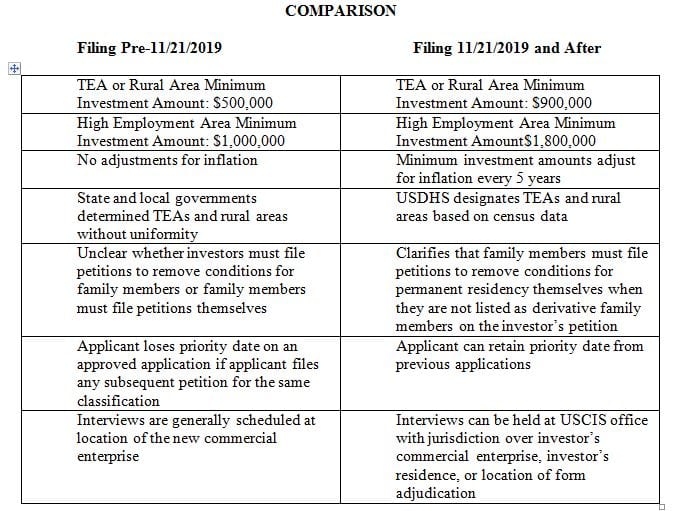EB-5 Immigrant Investor Program to Undergo Changes
July 30, 2019 | Henry M. Mascia |After 26 years, the U.S. Citizenship and Immigration Services (USCIS), a component of U.S. Department of Homeland Security (USDHS), published a new rule modernizing the Immigrant Investor Program with several changes. This is the first substantial revision to the Employment-Based Immigration: Fifth Preference or EB-5 Immigrant Investor Program since the program’s enactment in 1993. This new rule goes into effect on November 21, 2019. This bulletin will describe the changes in detail, and the chart at the end of this bulletin will summarize the changes.
The Current EB-5 Program
The current program allows individuals to apply for conditional lawful permanent residence in the United States as long as they invest in a U.S. commercial enterprise. There are two requirements that must be established for a period of two years in order to partake in the EB‑5 Immigrant Investor Program:
- The investment must create or sustain 10 full-time jobs for U.S. citizens, lawful permanent residents, or other immigrants authorized to work in the U.S., excluding the investor and the investor’s immediate family.
- The minimum investment requirement is $500,000 and must be made in a designated high-unemployment area or a rural area, considered targeted employment areas (TEAs). Alternatively, an individual could invest in an area that is not designated as a TEA with an increased investment requirement of $1 million.
Currently, states and local governments determine what areas are considered TEAs. Some of these governments mix census data of prosperous communities with census data of struggling communities to allow designation of prosperous areas as TEAs.
There are two types of investment that qualify for the EB-5 program. An EB-5 investor can either (a) invest in a commercial business established after Nov. 29, 1990 or (b) purchase a business established before November 29, 1990. If the investor purchases a business established before November 29, 1990, the investor must either restructure to establish a new commercial enterprise or keep the structure of the business and produce a 40% increase in businesses net worth or number of employees.
After the investment, the potential immigrant investor files an I-526, Immigrant Petition by Alien Investor, petition with USCIS to apply to become an EB-5 Immigrant investor. The date of submission of this petition becomes the “priority date” or date the applicant reveals intent to immigrate to the U.S. In a case where the initial application is denied or needs to be amended for a change in circumstances or to correct an error, a new priority date will be issued replacing any previously issued priority date. If an applicant has a priority date on or before the date listed on the latest United States Department of State (USDOS) Visa Bulletin, then that applicant is currently eligible for a visa.
USCIS typically interviews the EB-5 applicants at the purchased commercial business location. Even after approval, an applicant will be required to appear for an interview at a USCIS location to remove conditions or adjust his or her status. EB-5 investors can remove conditions for permanent residency by filing form I-829, Petition by Investor to Remove Conditions on Permanent Resident Status within 90 days before the two-year anniversary of the investor’s grant for conditional permanent residency. This form must be accompanied by supporting documentation showing that the job creation and capital investment requirements were met.
EB-5 Changes That Go Into Effect Nov. 21, 2019
The new rule changes the minimum investment amounts to $900,000 for TEAs and $1.8 million for non-TEAs to account for inflation since the program’s inception in 1993. The minimum investment amounts will now automatically adjust for inflation every five years. In order to address past and ongoing issues with boundary manipulation in determining what is considered a TEA, the USDHS will now make the TEA designations based on census data. The new rule clarifies that EB-5 investors’ family members must independently file to remove conditions on their permanent residency even though the investors’ petition to remove conditions should list family members. There is more flexibility in interview locations under the new rule. If the immigrant investor has a previously approved EB-5 petition, they can now retain the priority date of the pre-approved petition rather than losing their spot in line if they have to file a new petition, with a few exceptions. The new rule also adopts the current USCIS procedure for issuing Green Cards.
In order to take advantage of the lower capital requirements currently in place, a potential immigrant investor has limited time to file a petition before the raised capital investment amount goes into effect. Due to backdating, potential immigrants from China and Vietnam may have difficulty utilizing the current five-year and three-year backdates listed by USDOS and USCIS.
Potential immigrant investors should contact their attorney to discuss any potential implications the new rule could have on their plans to utilize the EB-5 Program.




